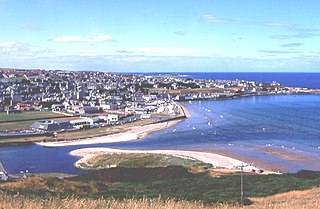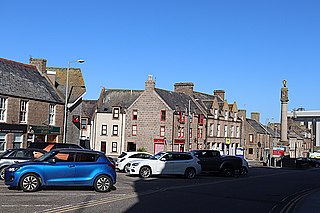
Banff and Buchan is a committee area of the Aberdeenshire Council, Scotland. It has a population of 35,742. Fishing and agriculture are important industries, together with associated processing and service activity.

Peterhead is a town in Aberdeenshire, Scotland. It is Aberdeenshire's biggest settlement, with a population of 18,537 at the 2011 Census. It is also the largest fishing port in the United Kingdom for total landings by UK vessels, according to a 2019 survey.

Banff is a town in the Banff and Buchan area of Aberdeenshire, Scotland. It is situated on Banff Bay and faces the town of Macduff across the estuary of the River Deveron. It is a former royal burgh, and is the county town of the historic county of Banffshire.

Buchanhaven is a village in Aberdeenshire, Scotland, dating to around 1739. It is one mile north of Peterhead town centre, and near to the mouth of the River Ugie. It has its own school, Buchanhaven Primary School, which caters for children in Buchanhaven and the nearby Waterside estate. It is also the home of Buchanhaven Hearts F.C.

Mintlaw(literally meaning a smooth, flat place) is a large village in Aberdeenshire, Scotland lying along the A952 road and is geographically a route centre. The 2001 UK census records a population of 2,647 people.

Longside is a village located in Aberdeenshire, Scotland and consists of a single main street. It lies seven miles inland from Peterhead and two miles from Mintlaw on the A950. Its population in 2001 was 721. The River Ugie flows through it.

Pitsligo Castle is a ruined castle half a mile east of Rosehearty, Aberdeenshire, Scotland. Modified in the 1570s by the Forbes of Druminnor, it was described by W. Douglas Simpson as one of the nine castles of the Knuckle, referring to the rocky headland of north-east Aberdeenshire.

Brethren Meeting House is a Category C listed building at 26 Gordon Street in Boddam, Aberdeenshire, Scotland. It was formerly a late-Victorian-era Wesleyan church. A bellcote is on the gable, without a bell but with a "spiky" finial in place.

Boddam Castle is a ruined castle in Boddam, Aberdeenshire, Scotland. It was thought to have been built in the early 16th century as a seat for the Keiths of Ludquharn. It is a scheduled monument and was a Category B listed structure, though this was removed in 2015.
32 Broad Street is a Category B listed building at 32 Broad Street in Peterhead, Aberdeenshire, Scotland. It was built in 1858. Originally a Union Bank of Scotland, it is now home to a Bank of Scotland.

The Reform Monument is a Category B listed monument on Broad Street, at its junction with Longate, in Peterhead, Scotland, built in 1833. A Roman doric column, it is surmounted by arms of Earl Marischal, inspired by the gateway of Inverugie Castle.
Kirkburn House is a Category B listed building on South Road in Peterhead, Aberdeenshire, Scotland. It was the manse for the adjacent, now-ruined Old St Peter’s Church. Its name refers to the now-culverted burn in the hollow alongside the building.

The Howe o'Buchan House is a Category C listed building on Inverugie Road in Peterhead, Aberdeenshire, Scotland. It dates from 1840, and is a two-storey residential building. The house contains a marble chimneypiece that dates from circa 1805. It also contains a sculptured panel and bannisters which originated from Brucklay Castle.

The Fish-House is a Category B listed building on Golf Road in the Inverugie area of Peterhead, Aberdeenshire, Scotland. One of the two right-angled blocks dates from 1585, making it the oldest building in Peterhead. Walker and Woodworth state the structure was built as a coastal store for Inverugie Castle by William Keith, 4th Earl Marischal, whose initials are on a skewputt. They also state that it was "rebuilt c. 1801," but without clarification as to which building.
16 Prince Street is a Category B listed building in Peterhead, Aberdeenshire, Scotland. It dates from 1838. It was formerly Peterhead's infant school, colloquially known as the Chuckney School. Today it is an office building for Aberdeenshire Council.

Old St Peter's Church is a scheduled monument in Peterhead, Aberdeenshire, Scotland. While the medieval main tower is still standing, only ruins remain of its other sections, some of which date to the 12th century. The pyramid roof of the tower is believed to be 18th century.

Old Parish Church is a Category A listed building located on Maiden Street in Peterhead, Aberdeenshire, Scotland. Local brothers Robert and John Mitchell built the church between 1804 and 1806, to a design by Alexander Laing, of Edinburgh. Its Burgerhuys bell dates to 1647.

75 Broad Street is a Category B listed building in Peterhead, Aberdeenshire, Scotland. It dates to 1835, and was originally a Clydesdale Bank. It is believed to have been designed by Archibald Simpson.

The Bath House is a Category B listed building in Peterhead, Aberdeenshire, Scotland. Located at 7 Bath Street, it dates to around 1812.

Peterhead Town House is a municipal structure in Broad Street, Peterhead, Aberdeenshire, Scotland. The building, which was the headquarters of Peterhead Burgh Council, is a Category B listed building.




















